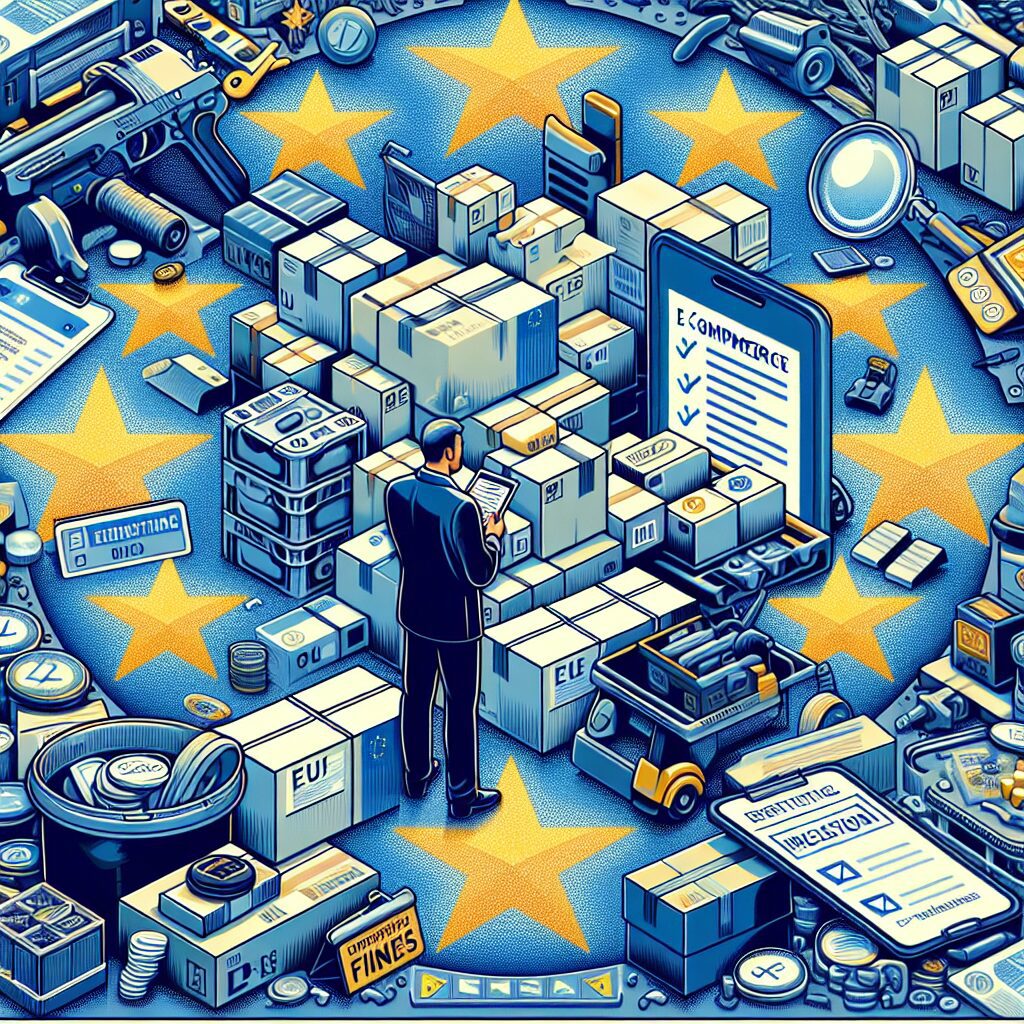About eldris
At Eldris, we automate SEO, multilingual site expansion, and EU compliance for brands scaling across Europe. Our AI-powered platform handles everything from content publishing to regulatory docs—so you don’t have to.
In This Article
- Register for EU EPR compliance before shipping products to EU buyers.
- Understand obligations across packaging, batteries, and electronics categories.
- Avoid fines and marketplace suspensions with timely registration and reporting.
- Use automation software for accurate, scalable data collection.
- Reference [INSERT_INTERNAL_LINK_1] for advanced compliance tools and guides.
What Is EU EPR Compliance?
Understanding Extended Producer Responsibility for E-Commerce
EU EPR compliance refers to a set of environmental regulations known as Extended Producer Responsibility (EPR), introduced across the European Union to ensure that manufacturers, sellers, and importers are accountable for the entire lifecycle of certain products. These rules aim to reduce waste and promote recycling by making the responsible parties financially and operationally liable for the collection, treatment, and disposal of products placed on the EU market. For e-commerce sellers, especially those targeting EU consumers, adhering to EU EPR compliance is not simply a recommendation—it is a legal necessity.
The legislation covers various product categories, primarily packaging, batteries, and electronic equipment, and applies to both businesses operating within the EU and non-EU sellers dispatching goods to EU customers. With the expansion of global online trade, EU EPR compliance ensures that every actor in the supply chain contributes fairly to the environmental and waste management objectives set forth by European authorities.
Failure to comply can lead to severe penalties, including fines, product sales bans, and potential removal from leading sales platforms such as Amazon or eBay. Consequently, it is imperative that businesses of all sizes fully understand and implement EU EPR compliance measures throughout their operations.

Who Must Comply with EU EPR?
Seller Categories and Thresholds Affected
EU EPR compliance affects a broad range of sellers, not solely large manufacturers. If you introduce products subject to EPR categories—such as electronics, packaging, or batteries—into an EU country for commercial purposes, you are considered a “producer” under EPR law. This applies even if you are located outside the EU, including dropshippers, Amazon FBA sellers, and direct-to-consumer brands operating through independent storefronts.
According to most national EPR frameworks, each member state identifies its own thresholds and conditions. In certain jurisdictions, EPR obligations begin with the sale of even a single qualifying product, while others only apply regulations after a specified annual sales volume or revenue has been reached. Therefore, it is vital to assess your specific sales data in each EU market to determine whether you fall under current EPR rules.
“If you sell into the EU—even as a non-resident—you must assess EU EPR compliance obligations based on where your customers are located, not where your business is registered.”
What Are the Penalties for Non-Compliance?
The financial and operational consequences of failing to meet EU EPR compliance obligations can be significant. Each EU member state enforces its own measures and penalties, but outcomes typically include administrative fines, account suspensions on marketplaces like Amazon and eBay, and bans on product sales until registration and reporting responsibilities are fulfilled.
Fines can range from €1,000 to over €100,000 depending on the nature and duration of non-compliance. In France, for instance, the Agency for Ecological Transition (ADEME) has issued enforcement threats to thousands of e-commerce sellers. Amazon, affected by local EPR enforcement, requires documentation of EPR registration before sellers can list certain products. Repeat violations can also trigger investigations, legal action, and reputational damage.
In addition to these risks, sellers who ignore EU EPR compliance may lose competitive positioning. Efficient compliance boosts your reputation, avoids operational disruptions, and signals responsibility to increasingly eco-conscious consumers.
Packaging, Batteries, and Electronics: Key EPR Categories
EU EPR schemes mainly focus on three core product areas: packaging, waste electrical and electronic equipment (WEEE), and portable or industrial batteries.
Packaging Waste Management
Every seller that uses packaging—boxes, plastic wrap, labels, and fillers—for shipment of products to EU buyers must register with their respective national EPR Packaging Scheme. Sellers are required to declare annually or quarterly how much packaging material they place into the EU market. This includes primary (product) packaging and secondary (shipping) packaging. Weights must be precise, often requiring detailed product weight audits and internal systems to track volumes faithfully.
Electrical and Electronic Equipment (EEE)
The WEEE directive governs all electronic items, from toasters and tablets to cables and circuit boards. Any product requiring electrical currents to function falls under this category. Sellers must register with national WEEE compliance schemes, assign Producer Responsibility Numbers, and ensure that recycling symbols and disposal information appear on packaging and instruction manuals.
Batteries and Accumulators
Whether integrated into products such as smartphones or delivered separately, batteries sold to EU end-users require separate EPR registration. Sellers must sort portable batteries, vehicle batteries, and industrial batteries accordingly and enlist with specific collection schemes. Labelling and disposal compliance are mandatory, as is correct volume reporting by type and chemistry.
Step-by-Step EU EPR Registration for Non-EU Sellers
Non-EU sellers must register for EU EPR schemes within each country they sell products into. While the registration processes vary by country, the general steps are as follows:
- Determine Your EPR Categories: Identify which product types (packaging, batteries, electronics) you offer that trigger EPR obligations.
- Select EPR Compliance Bodies: Choose certified Producer Responsibility Organisations (PROs) in each country, such as Der Grüne Punkt (Germany) or Léko (France).
- Appoint Local Legal Representatives: Appoint an Authorised Representative with a physical address within the country of sale, as mandated by many member states.
- Register and Obtain IDs: Complete the necessary registration forms and submit data. Upon approval, obtain unique registration numbers for each EPR category.
- Submit Reporting & Pay Fees: Based on item volumes sold and weight of packaging per country, file reports monthly or quarterly and pay calculated fees.
Keep documentation and communicate proactively with PROs to remain in line with requirements. For support navigating EPR systems, consider third-party platforms that specialise in multi-country compliance management. Learn more about EU E-Commerce Compliance & Legal Frameworks
Country-Specific Deadlines and EPR Bodies
Deadlines for EU EPR compliance and registration vary by member state. In Germany, for example, packaging compliance must be registered with the Zentrale Stelle Verpackungsregister (ZSVR) before the first sale. France’s ADEME expects producer numbers to be supplied immediately to platforms such as Cdiscount or FNAC. Spain and Italy have similar demands under their national EPR systems.
Familiarise yourself with deadlines and ongoing obligations per country. Most nations update regulations annually, so subscribing to compliance bulletins or using EPR-dedicated services is recommended.
For a comprehensive breakdown of country-specific regulators, fees, and timelines, consult the official European Commission resources or accredited PRO databases. How to keep your brand free from EPR fines
How to Automate Reporting and Stay Compliant
With multi-country operations, tracking weights, sales volumes, product categorisation, and disposal data can quickly become overwhelming. Fortunately, automation tools can simplify reporting and data submissions while ensuring year-round EU EPR compliance.
Software platforms such as ERP-integrated sustainability modules or purpose-built solutions (e.g., EPR-compliance geolocation tools) automate data pulls for each EU country. These tools enable easier submission of declarations, timely payments, and audit readiness.
Amazon sellers can integrate EPR certificate tracking directly into their seller dashboards. Meanwhile, using barcode-linked internal tracking reduces manual entries and helps streamline paperwork audits during seasonal sales spikes.
Always perform regular data accuracy checks and train internal staff on using the software correctly. Reliable data submission not only ensures regulatory adherence but also drives operational efficiencies. Read a related article
Checklist for EPR Compliance Before Selling in the EU
- ✔ Assess whether your product categories fall under EPR regulations by country.
- ✔ Identify legal thresholds and sales volumes applying to your business.
- ✔ Designate legal representatives in each applicable member state.
- ✔ Register with authorised EPR schemes in each country.
- ✔ Obtain and share registration numbers with marketplaces and buyers.
- ✔ Track and quantify product types and packaging weights in real time.
- ✔ Schedule declarations (monthly, quarterly, annually) per local requirements.
- ✔ Pay calculated fees promptly and keep all receipts.
- ✔ Automate where possible to minimise compliance risks and human error.
Impact on Online Marketplaces like Amazon & eBay
Online marketplaces play a major role in enforcing EU EPR compliance. Amazon, for example, has introduced mandatory Producer Responsibility registration fields for listings falling into EPR categories in Germany and France. Sellers who fail to provide proof of compliance can have listings removed or accounts suspended.
eBay has also implemented similar compliance verifications, directly notifying sellers when their products require national registration. These platforms expect documentary evidence such as LUCID IDs (Germany) or ADEME numbers (France) and frequently audit for correct seller classification.
Failure to register promptly can result in blocked sales, lost rankings, and penalties. Therefore, sellers should regularly check platform-specific compliance dashboards, respond promptly to EPR notifications, and maintain updated regulatory records. Seller checklist for EPR in Europe
Community Tips & Tools for EPR Management
Many successful EU e-commerce sellers rely on shared best practices. Community forums often share toolkits, local consultants, and preferred compliance bodies. Here are some industry-insider tips:
- 💡 Use barcode inventory systems that log product category and weight in real time.
- 💡 Subscribe to government and PRO newsletters to stay ahead of legislative changes.
- 💡 Join professional seller networks across Amazon Seller Central or Reddit to share representative contacts and tool integrations.
- 💡 Evaluate logistics partners that provide built-in EPR-compliant through labelling and reporting.
These practical solutions are essential for small sellers managing EPR obligations without dedicated internal legal teams or external agencies.
Conclusion: Make EU EPR Your Competitive Advantage
[CONCLUSION_CONTENT]
Great guide on eu-epr-compliance-guide-ecommerce-sellers – Community Feedback
Is EPR compliance mandatory for e-commerce sellers in Europe?
Yes, Extended Producer Responsibility (EPR) compliance is now mandatory for most e-commerce brands selling into the EU. Regulations cover packaging, electronic goods, and batteries, with high penalties for non-compliance.
What are the penalties for failing EU EPR compliance?
Penalties for EPR non-compliance in the EU can range from fines of €1,000 to €200,000 per offence, plus potential sales bans, delisting, and confiscation of profits.
How can I register for EPR in the EU as a non-EU seller?
Non-EU sellers must appoint a legal EU representative, register with relevant national authorities, and provide EPR numbers for packaging, electronics, and batteries as required in each country.








